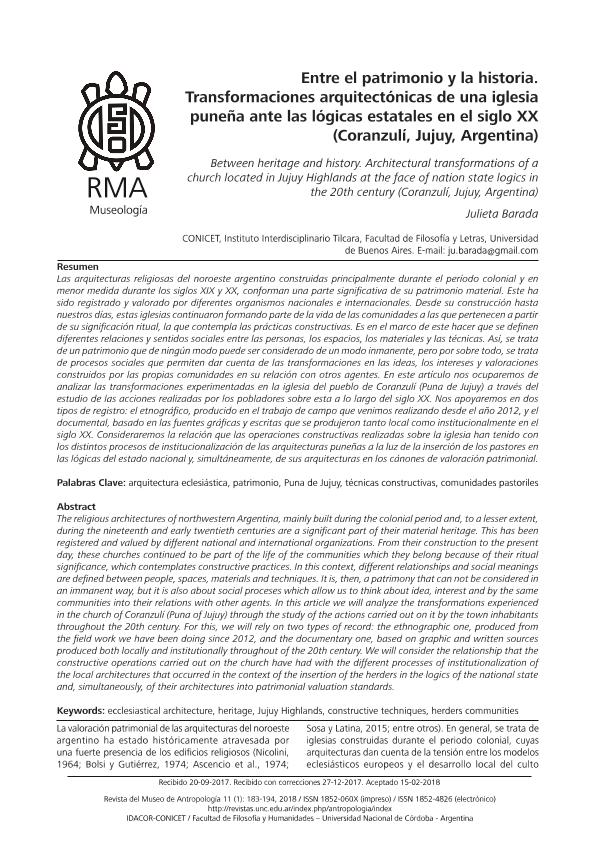Artículo
Las arquitecturas religiosas del noroeste argentino construidas principalmente durante el período colonial y en menor medida durante los siglos XIX y XX, conforman una parte significativa de su patrimonio material. Este ha sido registrado y valorado por diferentes organismos nacionales e internacionales. Desde su construcción hasta nuestros días, estas iglesias continuaron formando parte de la vida de las comunidades a las que pertenecen a partir de su significación ritual, la que contempla las prácticas constructivas. Es en el marco de este hacer que se definen diferentes relaciones y sentidos sociales entre las personas, los espacios, los materiales y las técnicas. Así, se trata de un patrimonio que de ningún modo puede ser considerado de un modo inmanente, pero por sobre todo, se trata de procesos sociales que permiten dar cuenta de las transformaciones en las ideas, los intereses y valoraciones construidos por las propias comunidades en su relación con otros agentes. En este artículo nos ocuparemos de analizar las transformaciones experimentadas en la iglesia del pueblo de Coranzulí (Puna de Jujuy) a través del estudio de las acciones realizadas por los pobladores sobre esta a lo largo del siglo XX. Nos apoyaremos en dos tipos de registro: el etnográfico, producido en el trabajo de campo que venimos realizando desde el año 2012, y el documental, basado en las fuentes gráficas y escritas que se produjeron tanto local como institucionalmente en el siglo XX. Consideraremos la relación que las operaciones constructivas realizadas sobre la iglesia han tenido con los distintos procesos de institucionalización de las arquitecturas puneñas a la luz de la inserción de los pastores en las lógicas del estado nacional y, simultáneamente, de sus arquitecturas en los cánones de valoración patrimonial. The religious architectures of northwestern Argentina, mainly built during the colonial period and, to a lesser extent, during the nineteenth and early twentieth centuries are a significant part of their material heritage. This has been registered and valued by different national and international organizations. From their construction to the present day, these churches continued to be part of the life of the communities which they belong because of their ritual significance, which contemplates constructive practices. In this context, different relationships and social meanings are defined between people, spaces, materials and techniques. It is, then, a patrimony that can not be considered in an immanent way, but it is also about social proceses which allow us to think about idea, interest and by the same communities into their relations with other agents. In this article we will analyze the transformations experienced in the church of Coranzulí (Puna of Jujuy) through the study of the actions carried out on it by the town inhabitants throughout the 20th century. For this, we will rely on two types of record: the ethnographic one, produced from the field work we have been doing since 2012, and the documentary one, based on graphic and written sources produced both locally and institutionally throughout of the 20th century. We will consider the relationship that the constructive operations carried out on the church have had with the different processes of institutionalization of the local architectures that occurred in the context of the insertion of the herders in the logics of the national state and, simultaneously, of their architectures into patrimonial valuation standards.
Entre el patrimonio y la historia: Transformaciones arquitectónicas de una iglesia puneña ante las lógicas estatales en el siglo XX (Coranzulí, Jujuy, Argentina)
Título:
Between heritage and history: Architectural transformations of a church located in Jujuy Highlands at the face of nation state logics in the 20th century (Coranzulí, Jujuy, Argentina)
Fecha de publicación:
04/2018
Editorial:
Universidad Nacional de Córdoba. Facultad de Filosofía y Humanidades. Museo de Antropología
Revista:
Revista del Museo de Antropología
ISSN:
1852-060X
e-ISSN:
1852-4826
Idioma:
Español
Tipo de recurso:
Artículo publicado
Clasificación temática:
Resumen
Palabras clave:
PATRIMONIO
,
ARQUITECTURA EN TIERRA
,
HISTORIA
,
IGLESIAS
Archivos asociados
Licencia
Identificadores
Colecciones
Articulos(CCT - SALTA-JUJUY)
Articulos de CTRO.CIENTIFICO TECNOL.CONICET - SALTA-JUJUY
Articulos de CTRO.CIENTIFICO TECNOL.CONICET - SALTA-JUJUY
Citación
Barada, Julieta; Entre el patrimonio y la historia: Transformaciones arquitectónicas de una iglesia puneña ante las lógicas estatales en el siglo XX (Coranzulí, Jujuy, Argentina); Universidad Nacional de Córdoba. Facultad de Filosofía y Humanidades. Museo de Antropología; Revista del Museo de Antropología; 11; 1; 4-2018; 183-194
Compartir




